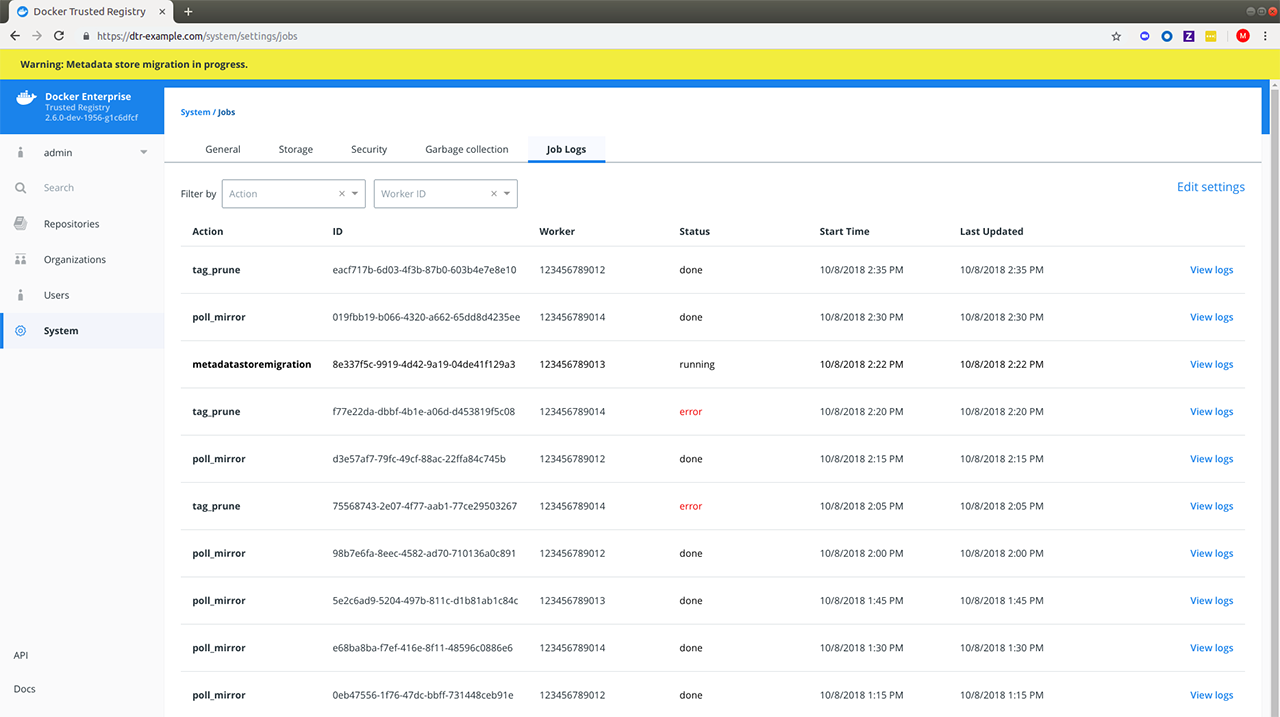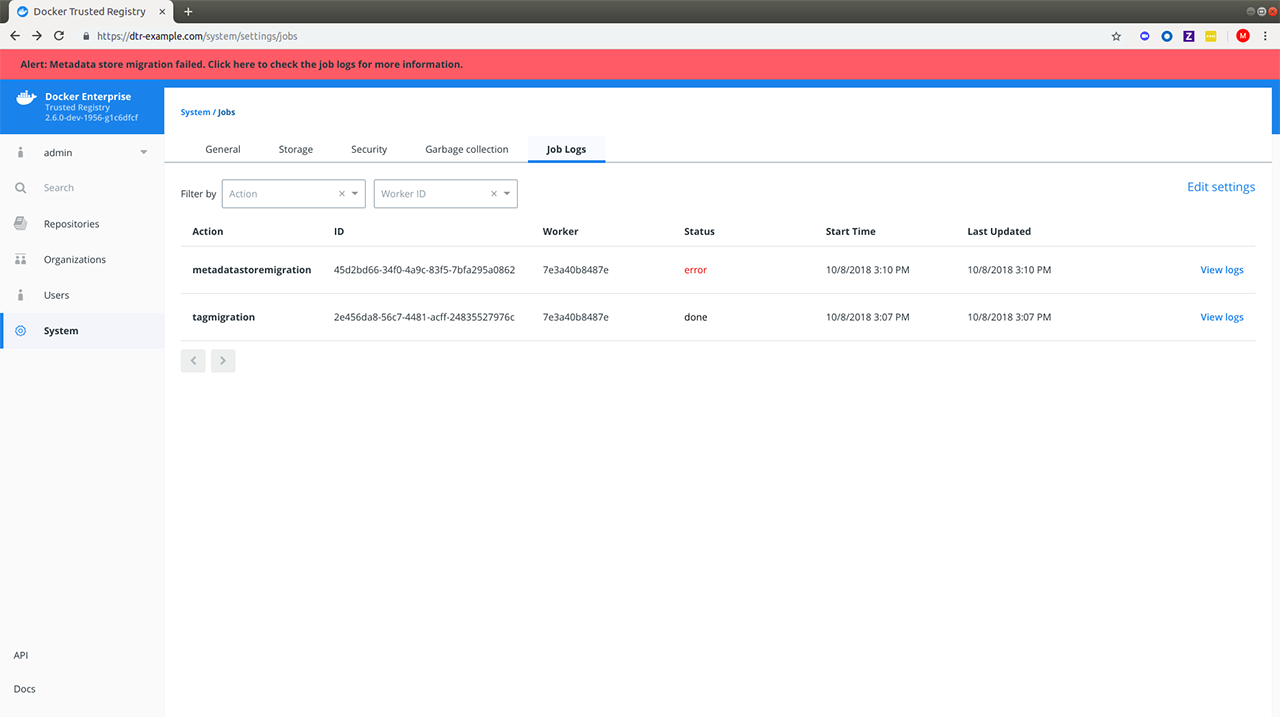Upgrade DTR
Estimated reading time: 5 minutesDTR uses semantic versioning and Docker aims to achieve specific guarantees while upgrading between versions. While downgrades are not supported, Docker supports upgrades according to the following rules:
- When upgrading from one patch version to another, you can skip patch versions because no data migration is done for patch versions.
- When upgrading between minor versions, you cannot skip versions, but you can upgrade from any patch version of the previous minor version to any patch version of the current minor version.
- When upgrading between major versions, make sure to upgrade one major version at a time – and also upgrade to the earliest available minor version. We strongly recommend upgrading to the latest minor/patch version for your major version first.
| Description | From | To | Supported |
|---|---|---|---|
| patch upgrade | x.y.0 | x.y.1 | yes |
| skip patch version | x.y.0 | x.y.2 | yes |
| patch downgrade | x.y.2 | x.y.1 | no |
| minor upgrade | x.y.* | x.y+1.* | yes |
| skip minor version | x.y.* | x.y+2.* | no |
| minor downgrade | x.y.* | x.y-1.* | no |
| skip major version | x.. | x+2.. | no |
| major downgrade | x.. | x-1.. | no |
| major upgrade | x.y.z | x+1.0.0 | yes |
| major upgrade skipping minor version | x.y.z | x+1.y+1.z | no |
There may be at most a few seconds of interruption during the upgrade of a DTR cluster. Schedule the upgrade to take place outside of peak hours to avoid any business impacts.
2.5 to 2.6 upgrade
Upgrade Best Practices
There are important changes to the upgrade process that, if not correctly followed, can have impact on the availability of applications running on the Swarm during upgrades. These constraints impact any upgrades coming from any version before
18.09to version18.09or greater. See Cluster Upgrade Best Practices for more details. Additionally, to ensure high availability during the DTR upgrade, you can also drain the DTR replicas and move their workloads to updated workers. To do this, you can join new workers as DTR replicas to your existing cluster and then remove the old replicas. See docker/dtr join and docker/dtr remove for command options and details.
Minor upgrade
Before starting your upgrade, make sure that:
- The version of UCP you are using is supported by the version of DTR you are trying to upgrade to. Check the compatibility matrix.
- You have a recent DTR backup.
- You disable Docker content trust in UCP.
- You meet the system requirements.
Step 1. Upgrade DTR to 2.5 if necessary
Make sure you are running DTR 2.5. If that is not the case, upgrade your installation to the 2.5 version.
Step 2. Upgrade DTR
Then pull the latest version of DTR:
docker pull docker/dtr:2.6.5
Make sure you have at least 16GB of available RAM on the node you are running the upgrade on. If the DTR node does not have access to the internet, you can follow the offline installation documentation to get the images.
Once you have the latest image on your machine (and the images on the target nodes if upgrading offline), run the upgrade command:
docker run -it --rm \
docker/dtr:2.6.5 upgrade \
--ucp-insecure-tls
By default the upgrade command runs in interactive mode and prompts you for any necessary information. You can also check the reference documentation for other existing flags.
The upgrade command will start replacing every container in your DTR cluster, one replica at a time. It will also perform certain data migrations. If anything fails or the upgrade is interrupted for any reason, you can rerun the upgrade command and it will resume from where it left off.
Metadata Store Migration
When upgrading from 2.5 to 2.6, the system will run a metadatastoremigration job after a successful upgrade. This involves migrating the blob links for your images which is necessary for online garbage collection. With 2.6, you can log in to the DTR web interface and navigate to System > Job Logs to check the status of the metadatastoremigration job. See Audit Jobs via the Web Interface for more details.

Garbage collection is disabled while the migration is running. In the case of a failed metadatastoremigration, the system will retry twice.

If the three attempts fail, you will have to retrigger the metadatastoremigration job manually. To do so, send a POST request to the /api/v0/jobs endpoint:
curl https://<dtr-external-url>/api/v0/jobs -X POST \
-u username:accesstoken -H 'Content-Type':'application/json' -d \
'{"action": "metadatastoremigration"}'
Alternatively, select API from the bottom left navigation pane of the DTR web interface and use the Swagger UI to send your API request.
Patch upgrade
A patch upgrade changes only the DTR containers and is always safer than a minor version upgrade. The command is the same as for a minor upgrade.
DTR cache upgrade
If you have previously deployed a cache, make sure to upgrade the node dedicated for your cache to keep it in sync with your upstream DTR replicas. This prevents authentication errors and other weird behaviors.
Download the vulnerability database
After upgrading DTR, you need to redownload the vulnerability database. Learn how to update your vulnerability database.